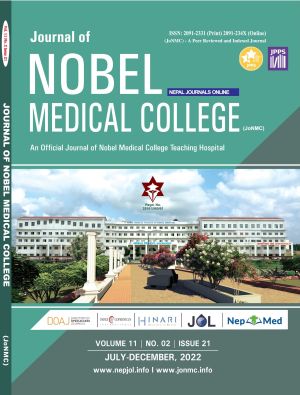Indications and Visual Outcome in Patients Undergoing Penetrating Keratoplasty
DOI:
https://doi.org/10.3126/jonmc.v11i2.50438Keywords:
Corneal opacity, Corneal ulcer, Penetrating keratoplastyAbstract
Background: Penetrating keratoplasty is commonly performed surgery in patients suffering from corneal blindness and visual impairment, where full thickness diseased cornea is replaced with healthy cornea. This study aims to outline indications of Penetrating keratoplasty and visual outcomes following the procedure.
Materials and Methods: This retrospective, hospital-based study included 48 eyes of 48 subjects fulfilling inclusion criteria and underwent Penetrating keratoplasty from January 2017-2020 at Bharatpur Eye Hospital. General ophthalmologic examination was done preoperatively and postoperatively. Indication of the surgery along with demographic outline and requisite investigations were performed.
Results: Mean age of the subjects was 47±1.83 years (13-74 years) where most of them were in 61-70years (23%) age group. Male subjects were more (62.5%) compared to females. Triple procedure was performed in 6.25 percent of patients. The most common indication was infective keratitis (52%) followed by corneal opacity/ scarring, regrafts, keratoconus and bullous keratopathy. Penetrating keratoplasty was performed slightly more for therapeutic purpose (52%) than optical. Intraoperative complications were observed in 16.7% of patients, positive vitreous pressure being the sole cause. Ameliorated visual acuity was observed in 71% of patients with43.75% of patients having VA of ≥3/60
Conclusion: Infective keratitis was the predominant indication followed by corneal opacity/ scarring. Penetrating keratoplasty helps in maintaining integrity of the globe along with restoration of vision
Downloads
Downloads
Published
How to Cite
Issue
Section
License

This work is licensed under a Creative Commons Attribution 4.0 International License.
JoNMC applies the Creative Commons Attribution (CC BY) license to works we publish. Under this license, authors retain ownership of the copyright for their content, but they allow anyone to download, reuse, reprint, modify, distribute and/or copy the content as long as the original authors and source are cited.




